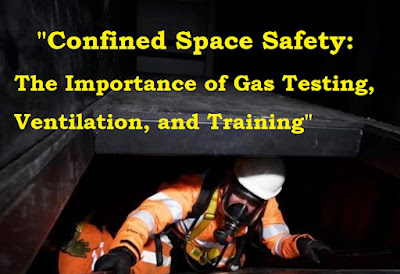Confined Space Safety: The Importance
of Gas Testing, Ventilation,
and Training
Confined
spaces are areas that are not intended for continuous human occupancy and have
limited or restricted means for entry and exit. These spaces can include tanks,
silos, vaults, and pipelines, and can present a number of hazards to those who
enter them. One of the most significant hazards associated with confined spaces
is the potential for toxic gas buildup.
Gas testing is an essential component of confined space safety and is used to determine the presence of hazardous gases, as well as the concentration levels of those gases. This information is critical for determining whether it is safe for workers to enter and work in the confined space.
There are several different types of gas testing equipment available, including portable gas detectors and fixed gas monitoring systems. Portable gas detectors are handheld devices that can be carried into the confined space and used to test for a variety of gases, including carbon monoxide, hydrogen sulfide, and oxygen. Fixed gas monitoring systems are installed in the confined space and continuously monitor for the presence of gases.
Before
entering a confined space, it is essential to conduct a thorough pre-entry
assessment to identify any potential hazards, including the presence of toxic
gases. This assessment should include a visual inspection of the space, as well
as gas testing to determine the concentration levels of any hazardous gases
present.
If hazardous gases are detected during the pre-entry assessment, it is essential to take immediate action to address the problem. This may include ventilating the space, installing gas detection and monitoring equipment, or taking other measures to reduce the risk of exposure to toxic gases.
Proper personal protective equipment (PPE) is also an essential component of confined space safety. This may include respirators, gas masks, and other protective clothing and equipment. It's important to ensure that workers are properly trained on the use and maintenance of PPE and that they are properly fitted with the equipment prior to entering the confined space.
Another
important aspect of confined space safety is emergency preparedness. This
includes having a plan in place for responding to emergencies, such as toxic
gas exposure or a fire, as well as ensuring that workers are properly trained
on emergency procedures.
Confined space safety is an ongoing process that requires ongoing monitoring, testing, and maintenance. Employers and employees must work together to create a culture of safety, and by doing so, they can create a safer and more productive work environment for everyone.
In addition to gas testing, there are several other key considerations when it comes to confined space safety. One of the most important is proper ventilation. Confined spaces that are poorly ventilated can quickly become dangerous, as toxic gases can accumulate and pose a serious threat to workers. Employers should ensure that proper ventilation systems are in place and that they are functioning properly. This may include installing fans or other equipment to remove toxic gases from the space, as well as opening windows or other openings to allow fresh air to flow in.
Another
important aspect of confined space safety is proper signage and warning
systems. This includes posting signs at the entrance to the confined space, as
well as installing alarms or other warning systems that will alert workers to
the presence of hazardous gases. Employers should also ensure that workers are
properly trained on how to respond to these warning systems and that they
understand the importance of immediately evacuating the space in the event of
an emergency.
Proper training is also an essential component of confined space safety. Workers should be properly trained on the hazards associated with confined spaces and on the proper procedures for working in these spaces. This includes training on gas testing, ventilation, and emergency procedures. Employers should also ensure that workers are properly trained on the use and maintenance of PPE, as well as the proper procedures for entering and exiting the confined space.
It's also important to have a rescue plan in place in case of an emergency. Rescue teams should be trained and equipped to handle confined space emergencies, including toxic gas exposure and other hazards. Employers should also ensure that the rescue teams are familiar with the layout of the confined space and the location of any potential hazards.
Employers
should conduct regular inspections and audits of their confined space safety
program to ensure that it is functioning effectively. This may include monitoring
the performance of gas testing equipment, checking for proper ventilation, and
reviewing emergency procedures. Employers should also review any incidents that
have occurred in the confined space and use that information to make any
necessary changes to their safety program.
Confined space safety is a critical issue that requires ongoing attention and commitment from employers and employees. By working together, employers and employees can create a culture of safety, and by doing so, they can create a safer and more productive work environment for everyone. It's important to follow OSHA standards and regulations, conducting regular training and audits, and having a proper rescue plan in place.
Confined
space safety, gas testing, hazardous gases, portable gas detectors, fixed gas
monitoring systems, pre-entry assessment, toxic gases, personal protective
equipment, emergency preparedness, training, culture of safety, ventilation,
signage and warning systems, training, rescue plan, inspections, audits, OSHA
standards.
"Confined
Space Safety: The Importance of Proper Gas Testing, Ventilation, and
Training"
"Ensuring
Safe Working Conditions in Confined Spaces: A Guide to Gas Testing and Other
Key Considerations"
"Confined
Space Safety: A Comprehensive Guide to Gas Testing, Ventilation, and Rescue
Procedures"
"Preventing
Accidents and Injuries in Confined Spaces: The Role of Gas Testing and Other
Safety Measures"
"Working
Safely in Confined Spaces: Understanding the Importance of Gas Testing,
Ventilation, and Training"

No comments:
Post a Comment